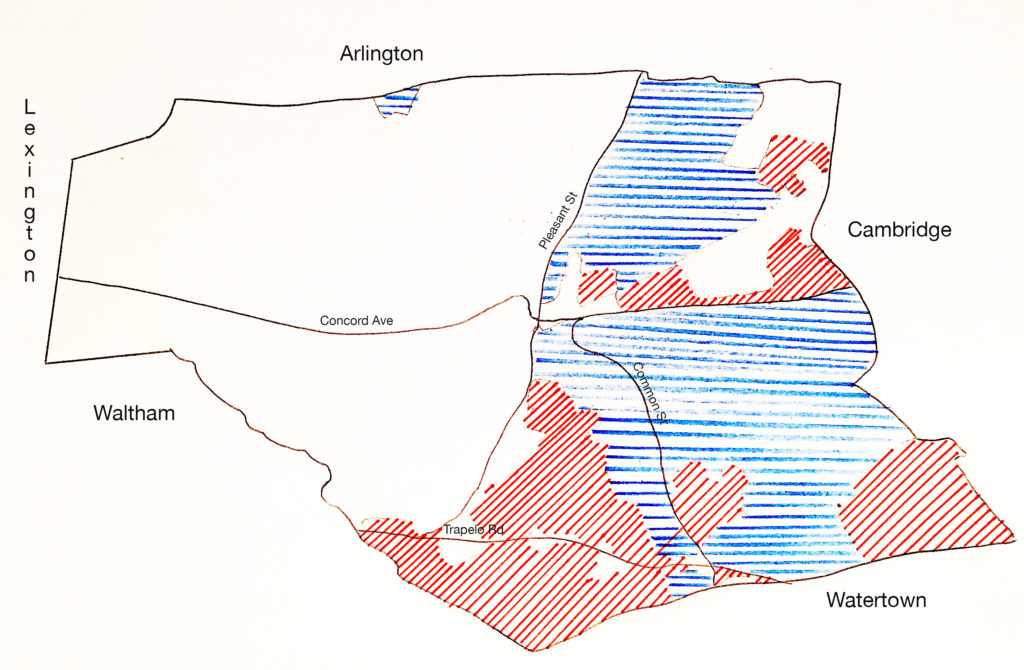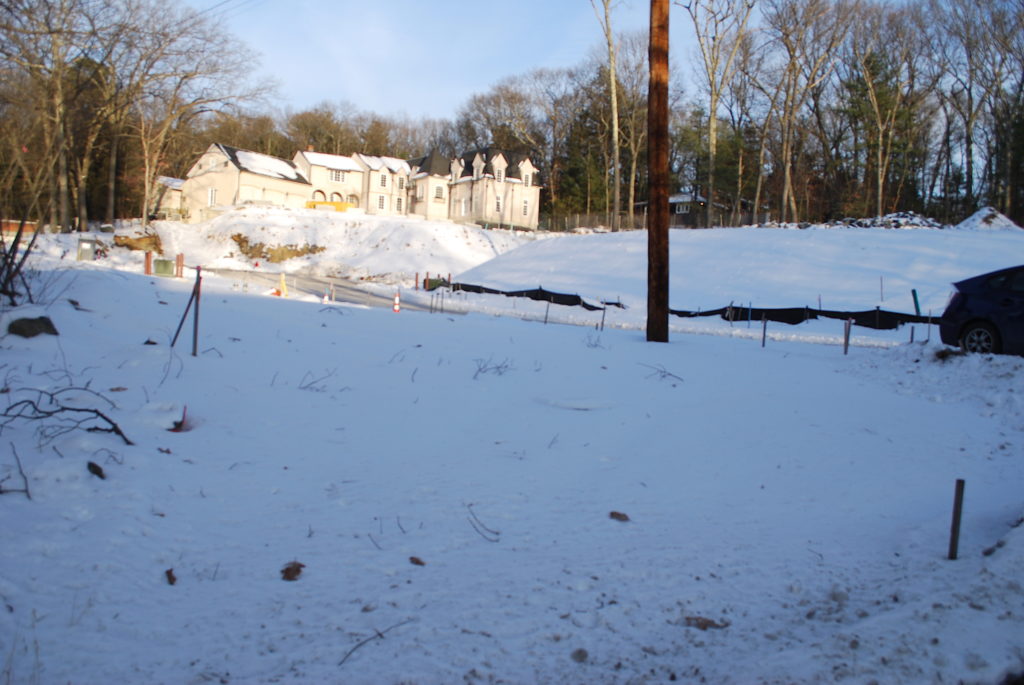
A simplified map of Belmont indicates the proportion of land zoned for General Residence (diagonal red lines) and Single Residence C (horizontal blue lines). In both zones, very large homes out of character with those around them have been built.
Looking Back, Looking Ahead
by Sue Bass
Nearly eight years ago, in the spring of 2010, the town completed two years of work on a comprehensive plan intended to guide the next decade of change in Belmont. Looking back, how are we doing?
The $148,000 plan, called “A Vision for Belmont: Mapping a Sustainable Future,” which was adopted by the Belmont Planning Board and is posted on its website, made nine primary recommendations:
• Enhance connections through open space, pedestrian, and bicycle infrastructure.
• Improve, support, and promote public transit.
• Expand housing choices for Belmont’s various and changing demographic groups.
• Reinforce Belmont’s neighborhoods and centers through historic and natural resource protection.
• Refocus control of future development on design guidelines and review process to supplement traditional zoning.
• Clarify the land use vision for each commercial area.
• Allow economically viable development which complements the town’s existing character.
• Revitalize commercial centers through public and private improvements.
• Link public facilities and financial planning to land-use priorities.
Community Path Denotes Progress
Some of those things are happening. The Board of Selectmen last month unanimously endorsed the community path that will enable people to walk or bike quickly from Waverley Square through Belmont Center to the Alewife T stop. That path will also help protect our two commuter rail stops at Belmont Center and Waverley Square by making them accessible to people in wheelchairs and to anyone pushing a stroller or pulling a suitcase.
The town defeated efforts by the MBTA to replace the two existing commuter stops in Belmont Center and Waverley Square (to which people can walk) with a single Belmont stop on Pleasant Street to which almost everyone would have to drive.
Our most important bus routes might improve if Cambridge creates dedicated bus lanes, as is now being discussed. Dedicated bus lanes in Belmont were not included in the reconstruction of Trapelo Road and Belmont Street. However, that reconstruction, funded by the state, did improve the streets and sidewalks through Waverley Square and Cushing Square, and a town-funded reconstruction of Belmont Center has improved its streets and sidewalks.
The town defeated efforts by the MBTA to replace the two existing commuter stops in Belmont Center and Waverley Square with a single one on Pleasant Street.
Parking Plan Aids Shoppers
The partial implementation last year of a 2012 parking plan for Belmont Center has at last made it possible for those with quick errands to park on Leonard Street. Private construction has brought new stores to Belmont Center, and Cushing Square should see better shopping whenever the construction there finishes. Meanwhile, Belmont developer Joe DeStefano plans to unveil a major proposal for Waverley Square this spring.
The completion of the Royal Belmont near Alewife and the Bradford in Cushing Square will provide more housing choices, both for the poor and those of moderate income, and the Belmont Housing Trust is working on a plan to increase the number of affordable units to 10% of the town’s housing stock and thus fend off unfriendly developments, as reported in the November/December 2017 issue of this newsletter.
There have been no expansions of historic districts or open space.
However, it is not clear how much progress, if any, has been made in historic and natural resource protection of Belmont’s neighborhoods and centers, in clarifying Belmont’s land-use vision, in linking public facilities and financial planning to land-use priorities, and in refocusing control of future development on design guidelines.
Belmont adopted the Community Preservation Act in November 2010, and Town Meeting passed a demolition delay bylaw in 2013 and strengthened it last year (see story in the September/October 2017 issue of this newsletter). Both were among the comprehensive plan’s recommendations. Yet the town has only approved one new historic district (in 2013, the Richardson Farm historic district, which protects three properties). There have been no expansions of historic districts or open space, though both have been discussed by the Belmont Historic District Commission. No new open space has been protected either.
Will Mansionization Be Slowed?
The Planning Board’s efforts have been concentrated on hearings under the General Residence rezoning passed in 2014, after residents demonstrated where oversized buildings had been crammed onto small lots. The Single Residence-C zoning changes were passed in 2016 for the same reason. Much of the board’s time recently has been spent considering applications under these bylaws. Selectman Adam Dash teased that members might have spent a little too much time deciding whether a particular homeowner could add a dormer, as if the Planning Board were a second Zoning Board of Appeals. The General Residence zoning expires this June and is likely to be kept, with some tweaks. “If you look at what’s been built [in the general residence districts] since Town Meeting [2014], it’s a dramatic change,” said Chuck Clark, who has served several terms on the Planning Board and was elected chairman in October.
Over the past few years, the Planning Board’s work has been disrupted by changes in leadership and in focus.

A developer has carved out a gully on a parcel on the northern end of Concord Avenue and named it St. James Court. Two more large homes are slated to be built here. (John DiCocco photo.)
Meanwhile, mansionization and the carving up of open space have continued elsewhere in town. A much-discussed proposal was Don Chiofaro’s plan to subdivide his land adjoining Habitat to add a number of new houses. That proposal has been withdrawn but could well resurface. Not far away, a developer scraped away a hillside off Concord Avenue to create a new cul de sac named St. James Court, removing stands of mature trees and creating a gully in the process. The new subdivision, approved by the Selectmen on January 11, 2016, will allow construction of two additional houses.
Planners to Look More Closely
Major zoning changes, both commercial and residential, have been prompted by citizen petitions. However, Clark said the Planning Board (PB) has begun to “lift up our heads a bit” to deal with the broader picture of town planning.
Belmont developer Joe DeStefano, who has developed commercial and residential property in various parts of town, said he’s not going to ask for zoning changes to build his new project in Waverley Square. “I’m going to work with the zoning that’s in place,” he said. With a special permit, zoning in this Local Business I zone allows buildings up to three stories and 32 feet in height. “LBI works. You need to be creative and you need to think,” DeStefano said. “The forefathers’ vision for the town was a good one. Belmont will never be Cambridge.”
DeStefano remarked that the overlay district for Cushing Square was not necessary. If that’s the case, it should be reconsidered. The overlay district as currently defined applies to buildings in Cushing Square that many would hate to see replaced, like the Winters complex and the stretch of Common Street that’s set back from the street.
New PB Members in Place
Over the past few years, the Planning Board’s work has been disrupted by changes in leadership and in focus. Jenny Fallon, who was chair when the comprehensive plan was adopted in 2010, was not reappointed.
Mansionization and the carving up of open space have continued elsewhere in town.
Most recently, the 2015–17 chair, Liz Allison, resigned after coming under fire from Clark, among others. Two new members, Thayer Donham and Ed Starzec, were appointed to the board by the selectmen in December. They were among 14 candidates for the volunteer jobs, giving the selectmen tough choices. Both are professional planners, bringing the number of planners on the PB to four of the six. In recent decades, Karl Haglund was the only professional planner on the board, and the McLean zoning of 1999 was produced by a Planning Board with no members who were professional planners.
Donham and Starzec join newly appointed associate member Edward Sanderson who replaced associate member Raffi Manjikian, who resigned in September.
Hopefully the newly reconstituted PB will take a closer look at any proposal for development that is not in line with what is best for Belmont as a whole, looking forward.
Sue Bass is cofounder and director emerita of the Belmont Citizens Forum, and a long-time Town Meeting member.


Sorry, the comment form is closed at this time.